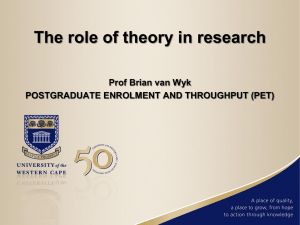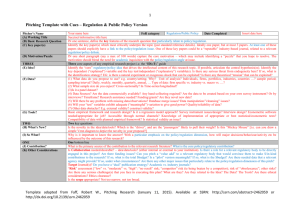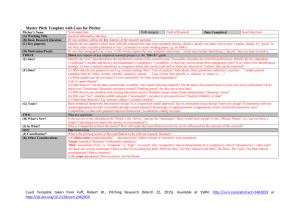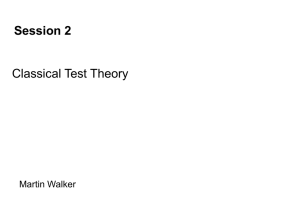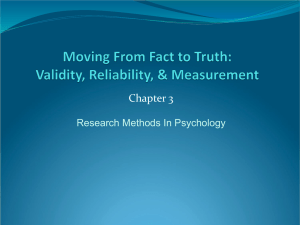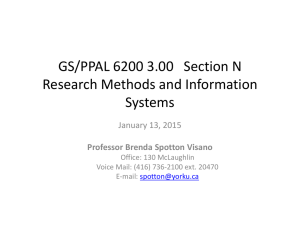PARTIAL GLOSSARY of Research Terms and
advertisement
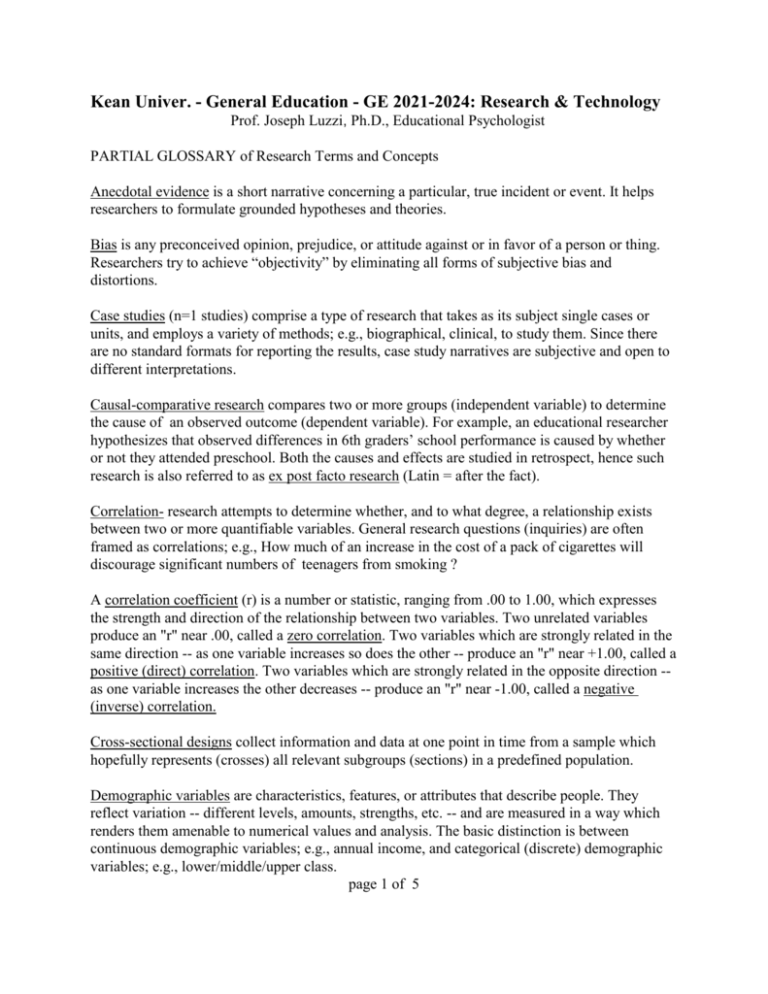
Kean Univer. - General Education - GE 2021-2024: Research & Technology Prof. Joseph Luzzi, Ph.D., Educational Psychologist PARTIAL GLOSSARY of Research Terms and Concepts Anecdotal evidence is a short narrative concerning a particular, true incident or event. It helps researchers to formulate grounded hypotheses and theories. Bias is any preconceived opinion, prejudice, or attitude against or in favor of a person or thing. Researchers try to achieve “objectivity” by eliminating all forms of subjective bias and distortions. Case studies (n=1 studies) comprise a type of research that takes as its subject single cases or units, and employs a variety of methods; e.g., biographical, clinical, to study them. Since there are no standard formats for reporting the results, case study narratives are subjective and open to different interpretations. Causal-comparative research compares two or more groups (independent variable) to determine the cause of an observed outcome (dependent variable). For example, an educational researcher hypothesizes that observed differences in 6th graders’ school performance is caused by whether or not they attended preschool. Both the causes and effects are studied in retrospect, hence such research is also referred to as ex post facto research (Latin = after the fact). Correlation- research attempts to determine whether, and to what degree, a relationship exists between two or more quantifiable variables. General research questions (inquiries) are often framed as correlations; e.g., How much of an increase in the cost of a pack of cigarettes will discourage significant numbers of teenagers from smoking ? A correlation coefficient (r) is a number or statistic, ranging from .00 to 1.00, which expresses the strength and direction of the relationship between two variables. Two unrelated variables produce an "r" near .00, called a zero correlation. Two variables which are strongly related in the same direction -- as one variable increases so does the other -- produce an "r" near +1.00, called a positive (direct) correlation. Two variables which are strongly related in the opposite direction -as one variable increases the other decreases -- produce an "r" near -1.00, called a negative (inverse) correlation. Cross-sectional designs collect information and data at one point in time from a sample which hopefully represents (crosses) all relevant subgroups (sections) in a predefined population. Demographic variables are characteristics, features, or attributes that describe people. They reflect variation -- different levels, amounts, strengths, etc. -- and are measured in a way which renders them amenable to numerical values and analysis. The basic distinction is between continuous demographic variables; e.g., annual income, and categorical (discrete) demographic variables; e.g., lower/middle/upper class. page 1 of 5 Descriptive statistics summarize the patterns in the responses within a data-set. They provide information about frequency distributions, central tendency, dispersion, correlations, etc. Empirical research provides concrete evidence -- sensory experience, observation, or experiment -- to verify theories and hypotheses. Its practical relevance is contrasted with abstract, groundless speculation, or bookish scholasticism. Epidemiology is a branch of medical science dealing with epidemic diseases such as AIDS and tuberculosis. Two common measures are incidence (number of new cases) and prevalence (total number of cases). Epidemiological researchers try to establish linkages between variables; i.e., smoking and lung cancer. Epistemology is a branch of philosophy and metaphysics that investigates the origin, nature, methods, and limits of human knowledge. It may be divided into two schools of thought: rationalism (innate knowledge) and empiricism (sensory experience). Ethnography is a type of fieldwork whereby the researcher (a) becomes a "participant observer" gaining close familiarity with a given social group through an intensive involvement with people in their natural environments, and (b) produces a written description thereof. Experimental designs require that all cases (subjects) are randomly assigned to either an experimental group which receives the treatment being assessed, or a control group which receives no treatment or a placebo. Results from the control group provide baseline information against which the effects of the experimental treatment can be measured. If there are no violations of internal validity the results can be interpreted in terms of cause and effect. Grounded theory argues for developing theoretical ideas from observations of the data themselves, i.e., inductive theory-building. This form of qualitative research is in contrast to the hypothetic-deductive model in which abstract, formal theory is developed by deducing (according to logical rules) hypotheses which are then tested or verified against observations. Hypothesis-testing involves a precise statement of a supposed relationship (either directional or non-directional) between the concepts under investigation, and the data-collection needed for the testing or verification to take place. Social scientists typically assume the null hypothesis and use statistical methods in the verification process. Inferential statistics allow researchers to generalize (extrapolate) from representative samples -by applying tests of significance and probability to patterns found in these samples -- to determine if results hold for populations as a whole. page 2 of 5 Levels of measurement constitute a model which states how empirical data are to be interpreted and quantified. The basic dichotomous distinction is between continuous variables, e.g., age and categorical (discrete) variables, e.g., educational level, race/ethnicity. Relatively few social variables are continuous -- forming interval scales such as age, annual income, number of dependents. Most are categorical (discrete) -- forming ordinal scales such as highest educational level achieved, or nominal scales such as race/ethnicity or sex/gender. The different levels of measurement have implications for the types of analysis that can be undertaken. Longitudinal studies assess the same group or cohort of participants, periodically over time. For example, the school performance of children enrolled in federally funded Head-Start programs may be evaluated every two years thru high school. The obvious disadvantage of a longitudinal approach is that participants must make an extended commitment to the project, to minimize sample shrinkage. Measures of central tendency include the mean (average), median (mid-point), and the mode (most frequent) in a given variable distribution. When the mean, median, and mode are equal the variable's frequency plot takes the shape of a normal distribution; i.e., bell-shaped curve. Methodology refers to the general approach, procedures, and techniques to empirical research. It addresses the fundamental questions about how scientists go about their work, conduct investigations, assess evidence, and how they decide what is true and false. Natural observation is a type of research whereby the investigator (a) feels that certain behaviors can best be observed as they occur naturally, and (b) remains unobtrusive, not affecting the observed situation in any way. For example, a sociologist at a large interracial, urban university might sit alone, quietly, in the main cafeteria during a busy lunch hour and count the number of students who are sitting, eating, and talking with students of a different race. Non-parametric statistics is a branch of statistical inference which makes no assumptions about the underlying distributional form of variables, hence it is sometimes called distribution-free statistics. Two commonly used tests of statistical significance are chi-square (for nominal-scaled variables) and the Mann-Whitney U-Test (for ordinal-scaled variables). A normal distribution or bell-shaped curve is a hypothetical mathematical distribution of numerical-values or scores which provides an idealized model (heuristic) for comparison with real, observed numerical-values or scores. Its shape is symmetrical and defined by its mean (average value/score), standard deviation (dispersion of values/scores), skew (extreme values/scores), and kurtosis (density of values/scores). page 3 of 5 Operational definitions transform abstract, theoretical concepts into something concrete, observable, and measurable in an empirical research project. They are often controversial, in part because they change across studies, thwarting direct comparisons of results. For example, a binge-drinker can be behaviorally defined as (a) someone who consumes five or more alcoholic drinks in one sitting, or (b) a "weekend warrior" who parties and drinks continually from Friday night thru Sunday morning. Phenomenology is a philosophical method of inquiry that involves the systematic investigation of consciousness -- including everything from our perceptions of objects to aesthetics. It often employs open-ended questions designed to reveal an interviewee's personal, subjective cognitions; i.e., qualitative data. Population refers to the aggregate of individuals or units under investigation, from which a sample is drawn and analyzed. Positivism is a philosophy of science within the empiricist tradition. Methods of social science are modeled after the natural sciences -- trying to discover social laws analogous to the law-like regularities, e.g., motion and gravity, discovered by physicists. Probability sampling requires that each case in the larger population (universe) being studied must have a determinate, or fixed, chance of being selected. Inferences or conclusions about the larger population can then be made from analysis of the sample. Two common designs are the simple random design -- each case has an equal chance of being selected; and the stratified random design -- the population is first divided into sub-groups called strata, and then random sampling is applied within the strata. Reliability is the degree to which a research procedure consistently measures something. Temporal reliability is obtained when the same measurement is repeated at a later time and remains stable; e.g., test-retest. Comparative reliability is obtained when "versions" of a measurement are administered at the same session; e.g., alternate forms of the same test, or splithalves of a very long instrument. Sample size refers to the number of individuals or units selected for analysis. Its important in determining how well the sample represents the population from which it was drawn. Serendipity refers to desirable discoveries that are made by accident. AIDS researchers found that AZT sometimes blocked uterine transmission of the human immunodeficiency virus to fetuses. Theories subsume a set of interrelated definitions and relationships that organize our concepts of and understanding of the empirical world in a systematic way. page 4 of 5 Triangulation combines two or more theoretical perspectives, methods of data collection, and data sets for empirical research on one issue or topic. In particular, macro-level and micro-level should complement and verify each other to achieve robust research results. Validity is the degree to which a research instrument measures the concept or property which it claims to measure. In the social sciences it relates to a particular purpose and a particular group of people. There are several types of validity: content (face) validity requires approval from experts or judges who are familiar with the topic in question; construct, concurrent, and predictive validity require quantifiable, external criteria. Variables are concepts that can assume any one of a range of values; e.g., height, income, ethnicity, self-esteem. The functional roles of variables are determined, in part, by the research design. For example, in a two-dimensional plot the X-variable (comprising the horizontal axis) is "antecedent" to the Y-dependent variable (comprising the vertical axis). In an experimental research design the X-variable functions as an independent variable, because the experimenter manipulates it beforehand. In a correlation-research design the X-variable functions as a predictor variable. Sometimes an intervening variable "Z" functions as a "control". Hence, the relationship between income and educational level may be controlled for and analyzed by residence; e.g., urban, suburban, rural. page 5 of 5


